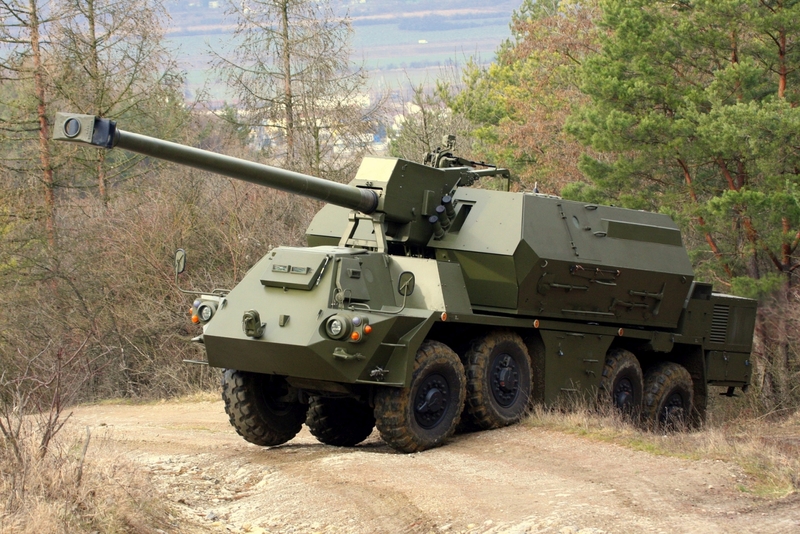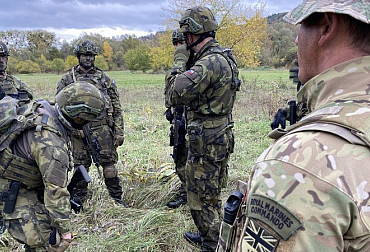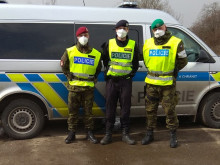CAESAR and DITA howitzers: Different approaches, not direct competition
The new 155mm DITA self-propelled howitzer from Excalibur Army was officially introduced at the IDEX 2021 arms trade fair in February in the United Arab Emirates. It became the subject of great interest of the professional public, but it also provoked controversy, as it is occasionally used as a tool for criticizing the decision of the Czech Army to acquire self-propelled howitzers of the CAESAR type. To a large extent, these are similar arguments to those used on the same topic in favor of the Zuzana 2 self-propelled howitzer of Slovak production. At this point, however, it should be emphasized that although the Slovak system is undoubtedly a very powerful weapon and DITA has great technical and commercial potential, these are examples of a somewhat different concept, which can not be described as direct competition of the CAESAR type. To label one of them as "better" or "worse" than the other is actually misleading.
 Picture: 155mm SPH CAESAR 8x8 | Nexter Systems / CC BY-NC-ND
Picture: 155mm SPH CAESAR 8x8 | Nexter Systems / CC BY-NC-ND
The Slovak Zuzana 2 self-propelled howitzer and the new Czech DITA howitzer follow the construction of the famous M. 77 or DANA self-propelled wheeled howitzer. At the time, it undoubtedly belonged to the world's top and dramatically overtook the vast majority of competition with two unusual features. The first was the assembly of the weapon on a wheeled chassis, while at that time almost only tracked chassis were used. DANA remained practically unique for a long time, until the South African G6 system was added in the 1980s, and it was not until the 1990s that howitzers on truck chassis began to increase, the first of which was CAESAR. The second special feature of the DANA howitzer was its automatic loading device, which automatically loaded grenades and powder charges. It was these two features that gave the weapon its name, because the apparent girl's name is in fact an abbreviation of the term "Gun Loaded Automatically". In any case, it can be stated that DANA has made a significant contribution to the history of artillery weapons and its original basic design still boasts considerable evolutionary potential.
After all, Slovak weapon Zuzana 2 also proves it. It can be described as the de facto peak of the development line, which was created in Slovakia after the division of Czechoslovakia. Its industry first extended the barrel of the DANA howitzer from 37 to 47 calibers. This is how the Ondava type was created, but it was not mass-produced. The next step was the Zuzana self-propelled howitzer, which already uses the western caliber of 155 mm and won an export contract for the National Guard of Cyprus. The final result is the Zuzana 2 type, which is now introduced in the armament of the Slovak Army. In the Czech Republic, the efforts were oriented in a slightly different direction, because the Czech Army showed interest in modernizing the DANA system, but maintaining the 152 mm caliber (conversion of existing howitzers to 155 mm would be quite complicated and expensive, because both ammunition designs differ in concept of powder charges ). Thus, modernized versions of the DANA M1 and DANA M2 were created, and as the latest product, a 155 mm DITA howitzer was born, which, however, represents a completely new, albeit quite similar weapon.
.jpg) Picture: Wheeled DITA 155 mm cannon-howitzer | EXCALIBUR ARMY / CC BY-NC-ND
Picture: Wheeled DITA 155 mm cannon-howitzer | EXCALIBUR ARMY / CC BY-NC-ND
In any case, it is true that DANA, Zuzana and DITA use the same construction philosophy, namely the howitzer located in a massive armored turret on the eight-wheel chassis of the Tatra company. The South African type G6 is designed quite similarly, while the wheeled self-propelled howitzers, which began to appear in Western countries in the 1990s, are characterized by a different approach. It is described by the sometimes used abbreviation TMG (Truck Mounted Gun), as it is really a gun mounted on trucks. The basis is usually the chassis of a truck with six or eight wheels, at the rear of which there is a carriage with a howitzer. In essence, it can be said that it is mostly the assembly of originally towed guns on automobile chassis, which to some extent combines the advantages of towed and classic self-propelled guns, especially relatively low weight and at the same time high tactical mobility.
The French CAESAR system was originally created by using a derivative of a 155 mm caliber TRF1 towed howitzer, which was placed on a six-wheel Mercedes-Benz Unimog chassis. However, the standard version of the French Army is located on the chassis of the Renault Sherpa and foreign interested parties can choose other chassis, which is one important advantage of TMG howitzers category, because the armies of different countries do not have to introduce new platforms, respectively they can use "their" chassis to mount the gun. After all, this is demonstrated by the fact that the current version of the CAESAR system is installed on an eight-wheel Tatra Force chassis. After all, other types of this category also appeared on the chassis from the Kopřivnice car manufacturer, namely the South African T5 Condor, the Israeli ATMOS 2000 system or the experimental Indian MGS howitzer.
 Picture: Zuzana 2 Self-propelled wheeled howitzer | KONŠTRUKTA - Defense, a.s. / CC BY-NC-ND
Picture: Zuzana 2 Self-propelled wheeled howitzer | KONŠTRUKTA - Defense, a.s. / CC BY-NC-ND
Although DANA, Zuzana and DITA sometimes fall into the TMG category, it is clear from the previous description that they are representatives of a significantly different design philosophy. In this sense, they are closer to the classic self-propelled tracked howitzers, from which they differ just by wheeled chassis, but they coincide with the assembly of the weapon in a massive rotating turret. This relationship is also evidenced by the fact that in Slovakia there were also tracked modifications of the Zuzana howitzer, named Himalaya and Diana (the first has a T-72 tank chassis and the second Polish UPG-NG chassis), and that the turret of the new Czech DITA howitzer can be placed also on other chassis, including tracked ones. In any case, it is a different concept from installing a gun on the rear of a truck chassis, which today represents a more common solution, but it is somewhat misleading to put one of these concepts on top of the other, as both have some strengths and weaknesses. It therefore depends on the specific conditions and requirements of each army and it is not possible to state in general which of these solutions is "better".
The concept of DANA, Zuzana and DITA howitzers undoubtedly offers higher protection for the crew, which is always under the protection of armor. In the case of conventional TMG howitzers, which also includes the CAESAR, it is usually necessary for the operator to get out of the cabin and perform loading to conduct combat operations, as most of these types use manual or assisted loading. This is also the case with the current version of the CAESAR howitzer. To the left of the breech there are two loaders, who place powder charges in a device that inserts them into the chamber, while to the right there is a third loader, who takes care of grenades. However, their transfer from the boxes to this man is automated, because it is performed by a mechanical arm (in the original form of the CAESAR cannon, this activity must also be performed manually). However, there are also weapons with fully automatic loading, especially the British-Swedish Archer, a new version of the Israeli ATMOS 2000 system is to receive automated loading, and the French company Nexter wants to offer fully automatic loading for CAESAR, although this will probably mean a reduction in ammunition.
.jpg) Picture: DANA M2 152 mm Self-propelled wheel howitzer | EXCALIBUR ARMY / CC BY-NC-ND
Picture: DANA M2 152 mm Self-propelled wheel howitzer | EXCALIBUR ARMY / CC BY-NC-ND
At first glance, it may seem that types with an armored turret represent a better choice than those with a weapon on the rear of the car chassis, but the reality is somewhat more complicated. Automatic loading is logically more complex, which of course means a higher risk of failure and higher production and operating costs. Contrary to popular belief, this does not necessarily mean higher cadence, as the comparison of DANA, DITA and CAESAR howitzer fire clearly shows, as the first has a maximum cadence of 5 rounds per minute and the second 6 rounds per minute, but the CAESAR howitzer can fire 6 rounds in 45 seconds. To some extent, this is similar to comparing loading in the tanks of the Western and Soviet design schools, because the USSR did not introduce loading automation due to increased cadence (after all, the human loader in Western tanks usually works faster), but primarily to reduce crew numbers. By comparison, the DANA howitzer has a crew of five men, while the CAESAR system is served by three to five people, depending on the version, and the exceptional degree of automation of the DITA weapon has allowed the crew to be reduced to just two men.
The choice of the CAESAR howitzer is often criticized in the sense that in a combat situation, the crew outside the vehicle will be endangered by enemy fire, because current artillery radars can almost immediately determine their position and induce counter-battery fire. Although this statement in itself certainly seems logical, in reality it is a question of taking one specific situation out of the whole context. There is no denying that such a situation could arise in a war, but it is only one of a number of different threats that artillery systems may face. E.g. last year's conflict over Nagorno-Karabakh demonstrated the potential of combat drones. Those weapons pose a threat even to heavily armored combat vehicles. Artillery systems can also become targets of attacks in the rear, respectively in the apparent safety away from the front, however, it is generally not assumed that contemporary self-propelled howitzers (not even the turreted ones) should come into direct contact with the enemy. Such a situation should therefore be rather exceptional.
Related to this is the criticism of the CAESAR system in the sense that it is allegedly a "colonial" howitzer suitable mainly for expeditionary operations, not for the defense of domestic territory. There was even a direct claim that the main purpose of these weapons in the Czech Army would be to assist the French in Mali. It is undoubtedly true that the French Army has deployed its CAESAR weapons in several foreign operations (in addition to Mali also in Iraq or Afghanistan), but this weapon was also acquired by the armies of several other countries and other types of this category are gaining export success without any connection to the interests of France. There is no doubt, however, that the CAESAR howitzer became the winner of the Czech Army's tender, among other things, because it can boast of truly extensive combat experience, which the competition lacks. The fact that CAESAR is already introduced in a number of armies and other customers show interest, while the Zuzana 2 type is used only by the Slovak Army and further exports do not seem very likely. This is also naturally related to one extremely important thing, which concerns the DITA howitzer.
The claim that if a modern Czech howitzer DITA is available, it was a mistake to choose the CAESAR type for the Czech Army is in fact extremely misleading. CAESAR has been a well-established weapon for many years, which has been well established in operation and in real combat, while DITA is currently only an experimental demonstrator. The concept of the DITA howitzer undoubtedly has enormous potential and can be compared to the top products of the world's powers, which it can even partially surpass, as shown by the enormous degree of automation, thanks to which DITA has only a two-member crew. At the moment, however, we can only really talk seriously about the future potential, because the development of the DITA howitzer is far from complete. Extensive tests must now take place, on the basis of which a prototype of the serial version will be created, and as soon as a customer is found, serial production can begin, but it will all take several more years, so DITA is simply not really "available" for the Czech Army at this time.
It can certainly be very tempting to imagine a DITA howitzer in the colors of the Czech Army, and it cannot be ruled out that this step will be taken, but so far it is a question of the distant future when DANA howitzers will be scrapped and their replacement purchased directly. On the contrary, CAESAR represents a currently available solution to the current requirement, because the Czech Army needs a 155 mm artillery weapon so that Czech artillerymen can participate in joint operations, resp. cooperate more effectively with NATO and EU allies. It does not have to be just Afghanistan, Mali or other exotic locations, because the current international situation suggests that the need to use NATO artillery can very quickly arise in Eastern Europe, the Balkans and the Mediterranean. The choice of the CAESAR weapon also makes sense from an economic point of view, as this weapon offered the best ratio of performance and price.
It is also worth mentioning the broader dimension of Czech-French cooperation, in which CAESAR is fitting. Nexter can be expected to be interested in further using this version of the CAESAR howitzer on the world market, which offers another great chance for Czech industry, because France can understandably enforce CAESAR howitzers on the Tatra chassis in countries where it has political or economic influence. In summary, CAESAR addresses current needs and gives Czech industry the position of an important subcontractor in a potentially large production and export program. The DITA howitzer then proves that Czech industry can also come up with world-class domestic programs that continue the famous tradition and can offer huge opportunities in the future. In fact, the involvement of Czech industry in the CAESAR project can help the DITA howitzer program to become successful in the future, and French and Czech industry can work together to develop next-generation artillery systems.





















